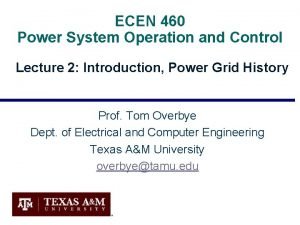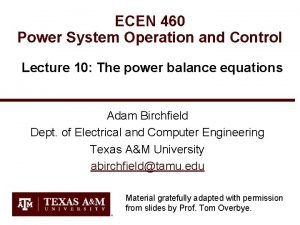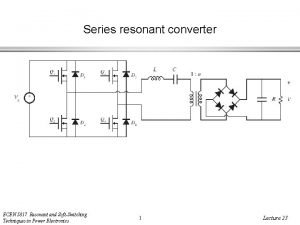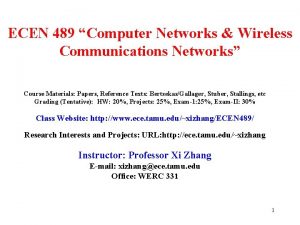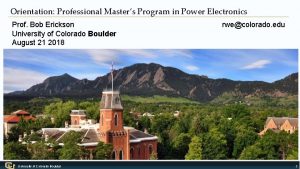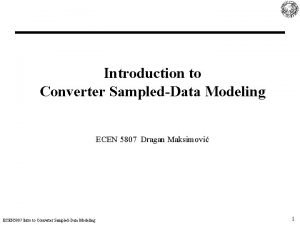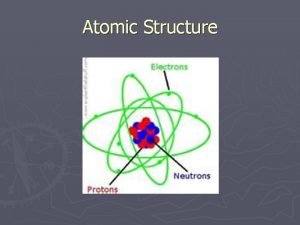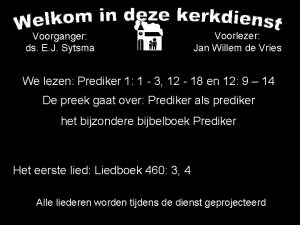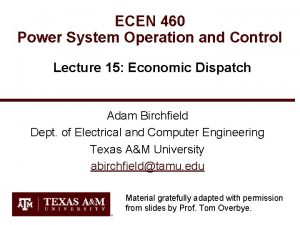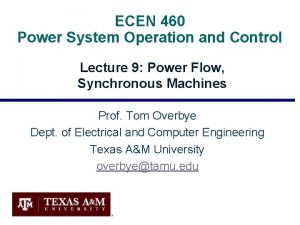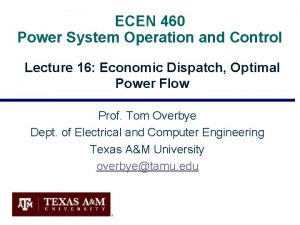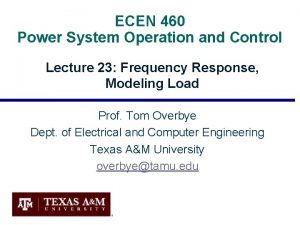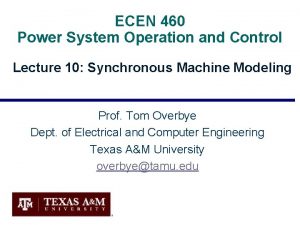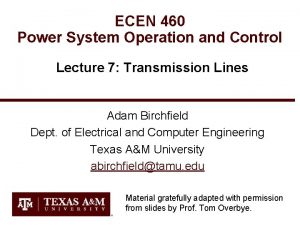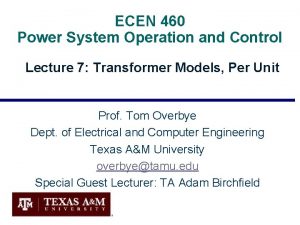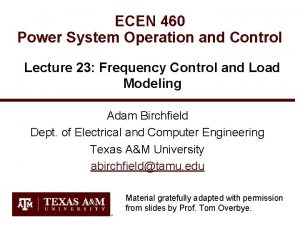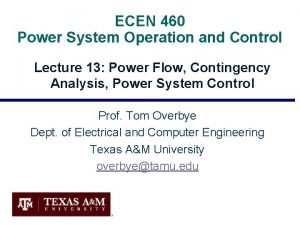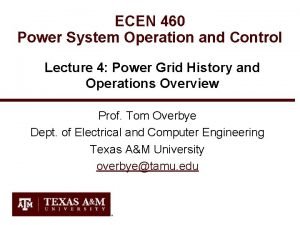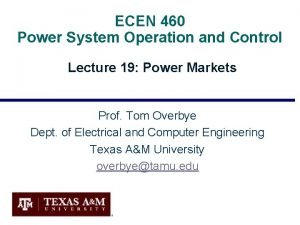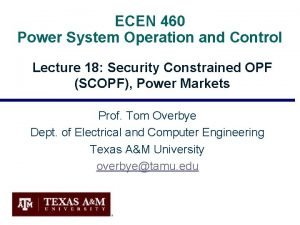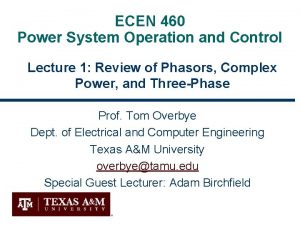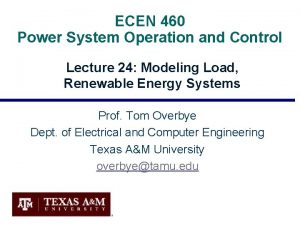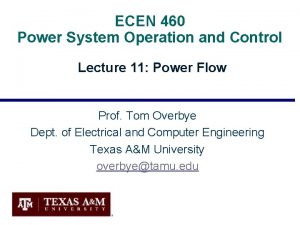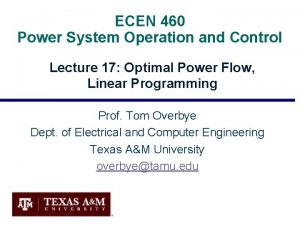ECEN 460 Power System Operation and Control Lecture






















- Slides: 22

ECEN 460 Power System Operation and Control Lecture 22: Governors and Exciters Adam Birchfield Dept. of Electrical and Computer Engineering Texas A&M University abirchfield@tamu. edu Material gratefully adapted with permission from slides by Prof. Tom Overbye.

1 Generator exciters and governors • The two-axis synchronous model takes as an input the field voltage and the mechanical power. The next section discusses how these values are controlled

2 Generator exciters • The purpose of the exciter is to maintain the generator terminal voltage (or other close by voltage) at a specified value. • • Input is the sensed voltage Output is the field voltage to the machine, Efd • Physically several technologies are used. • • Older generators used dc machines with brushes transferring the power With the newer brushless (or static) exciters power is obtained from an “inverted” synchronous generator whose field voltage is on the stator and armature windings are on rotor; output is rectified to create dc.

3 ABB UNICITER example Image source: www 02. abb. com, Brushless Excitation Systems Upgrade,

4 Exciter block diagrams • Block diagrams are used to setup the transient stability models. The common IEEE Type 1 exciter is shown below (neglecting saturation); this is a dc type exciter. Initial state values are determined by knowing Efd and the terminal voltage Vt.

5 Exciter block diagram example • Consider again the Example 11. 10 case, with an IEEE T 1 exciter with Tr = 0, Ka = 100, Ta = 0. 05, Vrmax = 5, Vrmin = -5, Ke = 1, Te = 0. 26, Kf = 0. 01 and Tf = 1. 0. Determine the initial states. Initial value of Efd = 2. 9135 and Vt = 1. 0946

6 Power. World example 12. 1 solution

7 Generator governors • The other key generator control system is the governor, which changes the mechanical power into the generator to maintain a desired speed and hence frequency. • Historically centrifugal “flyball” governors have been used to regulate the speed of devices such as steam engines • The centrifugal force varies with speed, opening or closing the throttle valve Photo source: en. wikipedia. org/wiki/Centrifugal_governor

8 Isochronous governors • Ideally we would like the governor to maintain the frequency at a constant value of 60 Hz (in North America) • This can be accomplished using an isochronous governor. • • A flyball governor is not an isochronous governor since the control action is proportional to the speed error An isochronous governor requires an integration of the speed error • Isochronous governors are used on stand alone generators but cannot be used on interconnected generators because of “hunting”

9 Generator “Hunting” • Control system “hunting” is oscillation around an equilibrium point • Trying to interconnect multiple isochronous generators will cause hunting because the frequency setpoints of the two generators are never exactly equal • • One will be accumulating a frequency error trying to speed up the system, whereas the other will be trying to slow it down The generators will NOT share the power load proportionally.

10 Droop control • The solution is to use what is known as droop control, in which the desired set point frequency is dependent upon the generator’s output R is known as the regulation constant or droop; a typical value is 4 or 5%.

11 Governor block diagrams • The block diagram for a simple stream unit, the TGOV 1 model, is shown below. The T 1 block models the governor delays, whereas the second block models the turbine response.

Example 12. 4 system response 12

Problem 12. 11 13

14 Restoring frequency to 60 Hz • In an interconnected power system the governors do not automatically restore the frequency to 60 Hz • Rather this is done via the ACE (area control area calculation). Previously we defined ACE as the difference between the actual real power exports from an area and the scheduled exports. But it has an additional term ACE = Pactual - Psched – 10 b(freqact - freqsched) • b is the balancing authority frequency bias in MW/0. 1 Hz with a negative sign. It is about 0. 8% of peak load/generation

2600 MW loss frequency recovery Frequency recovers in about ten minutes 15

Lab 9 intro: Running transient stability and critical clearing time 16

Lab 9 intro: Changing transient stability model parameters 17

Lab 9 intro: TSGC frequency response Use to retire generators 18

In the news: Luminant coal plant closings eliminate 600 Texas jobs • Dallas-based electricity generator Luminant is cutting about 600 jobs as it closes three coalfired power plants and a mine in Texas – Texas Workforce Commission said Nov 20, 2017 that Luminant plans to make the layoffs in January • Previously announced closing are at Monticello, Big Brown and Sandow power plants – – Closings are due to cheap natural gas, low wholesale power grids and increase in renewable generation Monticello is 1880 MW by Mount Pleasant, Big Brown is 1150 MW by Fairfield, Sandow is 1137 MW by Rockdale Source: Dallas. News. com, Nov 21, 2017 19

Our fictitious Texas grid company generator plant locations Red is nuclear, black is coal, brown is natural gas, green is wind, yellow is solar 20

21 Lab 9 intro: Power. World DS
 Ecen 460
Ecen 460 Ecen 460
Ecen 460 Ecen 5817
Ecen 5817 Ecen 621
Ecen 621 Ecen 621
Ecen 621 Ecen 621
Ecen 621 Ecen 489
Ecen 489 Colorado boulder power electronics
Colorado boulder power electronics Ecen 5807
Ecen 5807 Power system dynamics and stability lecture notes
Power system dynamics and stability lecture notes Power system dynamics and stability lecture notes
Power system dynamics and stability lecture notes Power system analysis lecture notes
Power system analysis lecture notes 01:640:244 lecture notes - lecture 15: plat, idah, farad
01:640:244 lecture notes - lecture 15: plat, idah, farad Draw power triangle
Draw power triangle Democritus theory of the universe
Democritus theory of the universe Apnak bang
Apnak bang 460 punkte abitur
460 punkte abitur Rent a lexus ls 460
Rent a lexus ls 460 Cis460
Cis460 460 democritus atom model
460 democritus atom model Liedboek 460
Liedboek 460 Historical healthcare figures
Historical healthcare figures Yüzlüğe yuvarlama hesap makinesi
Yüzlüğe yuvarlama hesap makinesi
